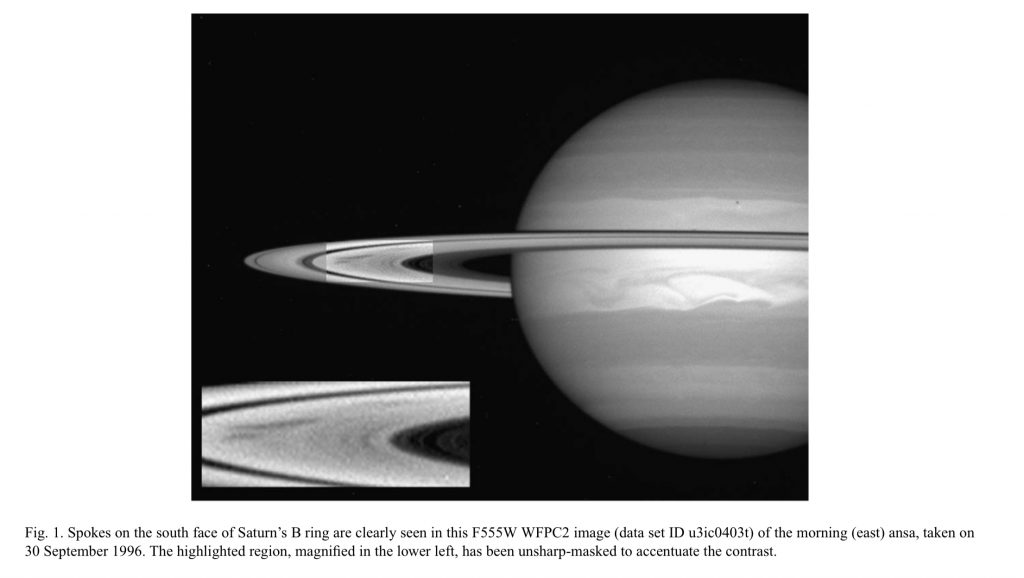
What’s that strange dark spot on the left side of Saturn’s rings? It’s in the B-ring and notice how it moves back and forth?
The animation above shows the movement of Saturn’s rotation over about a 2 hour period back on December 31, 2010. Using multiple images taken through an IR filter with a Celestron C14 telescope, I created the animation to show the black feature on the rings is rotating with the planet (therefore it’s not an artifact of the imaging process). The frames go forward and backward, making it appear that the black feature is moving backwards, but that’s just part of the illustration.
But what is that black spot? Very likely, they’re “spokes”. The spokes were first observed by the Voyager spacecraft and later by Cassini. It is believed they form when micrometer-sized dust particles are levitated above the ring by electrostatic forces. The image below, taken by the Hubble space telescope in September 1996, shows a “spoke” similar to the object in my image above, and was discussed in this article. (credit for the figure description to the authors)

Theories range on when they might be visible, and we have very little amateur imaging data to confirm when they might appear, but the best estimate we can make is that the spokes might be visible when the ring angle relative to the earth is from around 8 to 12 degrees, as it was shortly after the ring-plane crossing in 2010 into early 2011. However, the angle of Saturn’s rings relative to the Sun likely needs to be very low or even near zero for the spokes to form or become visible in the first place.
The best way to capture potential spokes is probably through an IR filter with a camera with good sensitivity in IR. Obviously, the scope must be well collimated and although a larger scope is more likely to capture evidence of spokes, it may be possible to capture them in apertures as small as 4-6″ under very steady skies. The next few apparitions are more favorable for northern observers than in recent years, so amateur astrophotographers across the globe should have a chance of catching the elusive spokes.

If spokes do form as Saturn’s ring plane approaches being edge-on to the AND we are at an angle of incidence to the rings (here on Earth) of around 8-12 degrees, then it’s likely that spokes will show up in amateur images IF all of the hypothesis we have are correct. I suspect we’ll learn something either way and should expected the unexpected.
Inevitably, though, if spokes do appear in amateur images there will be the immediate claims that the imager was the first to image spokes. For the record, the first recorded images of spokes were in 1994 from Pic du MIDI by Francois Colas with the legendary 1m cassegrain. Which amateur first imaged spokes is not as clear (if someone knows, please let me know), but not particularly relevant given the close relationship Francois and Pic du MIDI have enjoyed with the amateur community over the years. If you have images of spokes, please let me know via the site’s contact page.
For more information on Saturn’s Spokes and images taken by the Cassini and Voyager Spacecraft, check out these articles which were used for reference in this article. Links will open in a new window.
Saturn’s Mysterious Spokes
Finally . . . Spokes!
Spinning spokes in Saturn’s rings
HST observations of spokes in Saturn’s B-ring (pdf)